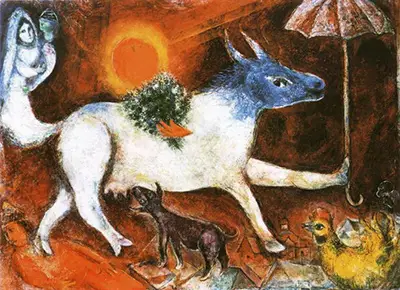The oil on canvas painting measures 106 x 77.5 cm. He was well known for his vibrant and larger than life paintings.
Chagall is considered within the art world to be one of the most prominent pioneers of the modern art movement. He is also held as one of the most established and acclaimed Jewish artists who painted within the 20th century.
It was during 1944 that Chagall sadly lost his wife, Bella Chagall, who died from a viral infection. They had been married for 29 years, and had been together many years before their marriage, with Chagall declaring that it had been love at first sight.
The two were inseparable, and had very much the same mindset in life, that of creating art and of not taking the world too seriously. Bella had been an accomplished writer, although although sadly never published any work in her lifetime.
The death of his wife was a incredibly traumatic life event for him, and hugely influenced his artistic works. In fact, he was unable to paint again for almost a year, as he was in deep mourning.
It was during 1946 that Chagall regained his love of art and painting when he decided to go back to Europe, the place where he first found a passion for his art. It was while in Europe, that Chagall was introduced to Virginia Haggard McNeill, and the two became lovers. It was this new found love that gave Chagall a renewed thirst for painting. One of those paintings inspired by McNeil was Cow with Parasol.
Cow with Parasol is pure fantasy. The absurdity of the image is very apparent. We observe a large cow, that dominates the canvas, seemingly walking along the rooftops of a sleepy village. The cow does all of this while holding a brightly coloured parasol. The entire image has been given the illusion of light and sunshine, as the sun is portrayed on canvas in the use of orange and yellow glowing tones. There are similarities with Yellow Cow by Franz Marc.
Although the painting is highly stylised, and completely absurd in nature, what Chagall had been successful in was that of portraying an animal on canvas, as that of a human. The eye sees the cow, but the brain can also see a human holding the parasol. This is an artistic technique that Chagall used regularly in his art works.
Although highly ironic, it helps to give the image greater meaning and emotion. Although Cow with Parasol features warm and homely colours, the cow stands out in its lack of colour, apart from its head. What ties in to this lack of colour, are the embracing couple who can be seen in the top left hand corner of the canvas. The woman appears to be a bride Are they observing the cow? Or is the cow observing then? Who are they? All of these are unanswered questions.
Chagall's first work was painted in 1908, but his most well known and respected works were painted in the years leading up to his death, those that were painted in the 1980's.
